| June 19, 2007 |  |
our time will build eternity |
| Previous Issues | Jun 18 | Jun 15 | Jun 14 | Jun 13 | Jun 12 |
Mars Rover Spirit Unearths Surprise Evidence Of Wetter Past Pasadena CA (SPX) May 22, 2007
Pasadena CA (SPX) May 22, 2007A patch of Martian soil analyzed by NASA's rover Spirit is so rich in silica that it may provide some of the strongest evidence yet that ancient Mars was much wetter than it is now. The processes that could have produced such a concentrated deposit of silica require the presence of water. Members of the rover science team heard from a colleague during a recent teleconference that the alpha ... more MARSIS Radar Estimates The Volume Of Water In The South Pole Of Mars  Paris, France (SPX) Apr 05, 2007
Paris, France (SPX) Apr 05, 2007By studying the South Polar region of Mars, the MARSIS (Mars Advanced Radar for Subsurface and Ionospheric Sounding) radar of the Mars Express space probe has enabled the structure of the layered deposits of this region to be elucidated. For the first time in the history of planetary exploration, topographic maps of the Martian sub-soil have been produced, revealing considerable volumes of ice.< ... more Mars Express Radar Gauges Water Quantity Around Martian South Pole  Paris, France (ESA) Mar 16, 2007
Paris, France (ESA) Mar 16, 2007The amount of water trapped in frozen layers over Mars' south polar region is equivalent to a liquid layer about 11 metres deep covering the planet. This new estimate comes from mapping the thickness of the dusty ice by the Mars Express radar instrument that has made more than 300 virtual slices through layered deposits covering the pole. The radar sees through icy layers to the lower boundary. ... more Early Mars Had Underground Water System  Paris (AFP) March 07, 2007
Paris (AFP) March 07, 2007Scientists on Thursday said they had found evidence that Mars was once latticed by an underground water system, proving that the Red Planet has had a long and complex relationship with one of the potential ingredients for life. Writing in the British journal Nature, researchers focussed on questions thrown up by NASA's Martian rover, Opportunity, in its exploration of a vast sloping plain called ... more Orbiter Provides New Hints Of Past Groundwater Flows On Mars  Pasadena CA (JPL) Feb 16, 2007
Pasadena CA (JPL) Feb 16, 2007A spacecraft recently arrived at Mars has provided new evidence that fluids, likely including water, once flowed widely through underlying bedrock in a canyon that is part of the great Martian rift valley. The new color images from the HiRISE camera aboard NASA's Mars Reconnaissance Orbiter show an equatorial landscape of hills composed of dozens of alternating layers of dark- and light-toned ro ... more |
mars-water-science
 mars-water-science  mars-water-science 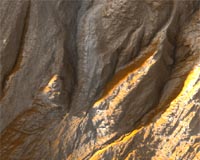 |
 Kingston ON (SPX) Oct 24, 2006
Kingston ON (SPX) Oct 24, 2006A Queen's University researcher has discovered a mineral that could explain the mountainous landscape of Mars, and have implications for NASA's next mission to the planet. "Satellites orbiting Mars show us images of canyons and gullies that appear to have been created by a flood or rapid out-washing," says Ron Peterson, Queen's geologist. "Exploration rovers, currently moving about on the ... more The Hydrogen Peroxide Snows Of Mars  Berkeley CA (SPX) Aug 08, 2006
Berkeley CA (SPX) Aug 08, 2006The planet-wide dust storms that periodically cloak Mars in a mantle of red may be generating a snow of corrosive chemicals, including hydrogen peroxide, that would be toxic to life, according to two new studies published in the most recent issue of the journal Astrobiology. Based on field studies on Earth, laboratory experiments and theoretical modeling, the researchers argue that oxidizing ... more Arkansas Planetary Science Center To Study Martian Water Chemistry  Fayetteville AR (SPX) Aug 01, 2006
Fayetteville AR (SPX) Aug 01, 2006A recent grant from NASA will enable the Arkansas Center for Space and Planetary Sciences at the University of Arkansas to continue its work creating missions to asteroids and exploring the possibilities and chemistry of water on Mars as part of the nation's space effort. The center received a grant of $1 million from NASA for its operations. "We are very grateful to the university a ... more New Mineral History Shows That Young Mars May Have Supported Life  Providence RI (SPX) Apr 21, 2006
Providence RI (SPX) Apr 21, 2006Mars started out relatively wet and temperate, underwent a major climate shift, and evolved into a cold, dry place strewn with acidic rock - less than ideal conditions for supporting life. This is the finding of an international team of scientists who have created the most comprehensive mineral history of Mars, a history closely linked to the presence of liquid water on the planet. Accordi ... more |
mars-water-science
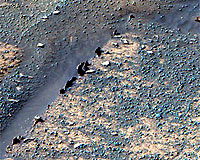 mars-water-science  mars-water-science 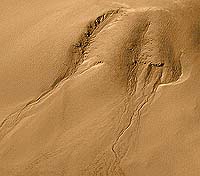 |
 Pasadena CA (JPL) Feb 02, 2006
Pasadena CA (JPL) Feb 02, 2006A proposed new robotic mission to Mars plans to make the first exploration of subsurface water ice in a potentially habitable zone. If approved, the Tracing Habitability, Organics and Resources (THOR) project � a low-cost mission designed for NASA's Mars Scout program � aims to send a projectile at high speed into the Martian surface while observing the impact and its aftermath. The mission ... more "THOR" Mars Mission To Seek Underground Water  Tempe AZ (SPX) Jan 26, 2006
Tempe AZ (SPX) Jan 26, 2006A new, low-cost mission concept to Mars would slam a projectile into the planet's surface in an attempt to look for subsurface water ice. "I'm interested in exploring mid-latitude areas of Mars that look like they're made of snow and ice," Phil Christensen, the project's principal investigator, told SpaceDaily.com. Christensen, of Arizona State University, and colleagues at NASA's Jet ... more Impacts, Not Water, Made Mars Formations, ASU Geologists Say  Tempe AZ (SPX) Jan 23, 2006
Tempe AZ (SPX) Jan 23, 2006ASU Professors of geological sciences L. Paul Knauth and Donald Burt think meteorites, rather than lakes, created the rock formations discovered by NASA's Opportunity rover. "What we've done is thrown out an alternative that we think is simpler," Knauth said. "A controversy has developed now." Knauth and Burt's hypothesis does not completely dismiss the idea that water once flowed on M ... more Martian Glaciers: Did They Originate From The Atmosphere  Paris (ESA) Jan 23, 2006
Paris (ESA) Jan 23, 2006The spectacular features visible today on the surface of the Red Planet indicate the past existence of Martian glaciers, but where did the ice come from? An international team of scientists have produced sophisticated climate simulations suggesting that geologically recent glaciers at low latitudes (that is near the present-day equator) may have formed through atmospheric precipitation of wa ... more
|
mars-water-science
 mars-water-science 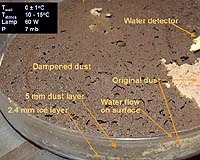 mars-water-science 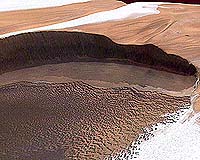 |
| Previous Issues | Jun 18 | Jun 15 | Jun 14 | Jun 13 | Jun 12 |
| The contents herein, unless otherwise known to be public domain, are Copyright 1995-2007 - SpaceDaily. AFP and UPI Wire Stories are copyright Agence France-Presse and United Press International. ESA Portal Reports are copyright European Space Agency. All NASA sourced material is public domain. Additional copyrights may apply in whole or part to other bona fide parties. Advertising does not imply endorsement, agreement or approval of any opinions, statements or information provided by SpaceDaily on any web page published or hosted by SpaceDaily. Privacy statement |